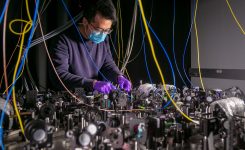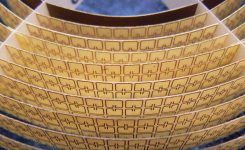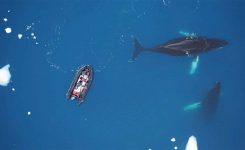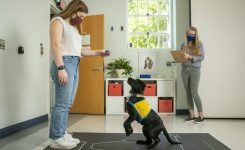Research
Exploring Earth’s Inner Space in a Submarine
Story and Photos by Karl Leif Bates
Two Duke scientists, a veteran and a newcomer, go to sea with Alvin.
Two-thirds of the Earth’s surface — and an untold quantity of its lifeforms — lie hidden beneath the oceans. Yet only a handful of scientific instruments are available to explore this vast wilderness, making it less understood than the Moon.
The most famous of these tools is the three-person research submarine, Deep Submergence Vehicle (DSV) Alvin.
For two weeks last summer, a pair of Duke marine scientists, one a living legend, the other an enthusiastic 30-year-old neophyte, joined the venerated submarine to explore the ocean shelf off Massachusetts.
Their experience was both extraordinary and everyday.
Cindy Van Dover
The legend, Cindy Lee Van Dover, is the first and only woman to be an Alvin pilot, a club much smaller than NASA’s astronaut corps. Now 63 years old, she has spent nearly 100 days of her life on the bottom of the ocean.
Van Dover was the scientific leader for this National Science Foundation expedition, which brought together 24 young scientists from all over the country in the name of training the next generation of deep-sea scientists.
The Alvin neophyte was Laura Bagge, a fifth-year Duke graduate student finishing her Ph.D. in the Sönke Johnsen Lab. She studies sea creature vision and camouflage in the vast twilight depths where sunlight fails and the darkness of the ocean deep begins.
Bagge’s Alvin dive on the edge of the continental shelf southeast of Nantucket, Mass. marked another first as well. With the support of some lobbying by Van Dover, Alvin was used in a new way: hovering at three depths on the way down to turn on the lights and collect specimens, rather than making the usual nonstop and dataless plunge directly to the bottom.
Laura Bagge

Note: 360 videos work best in Chrome, Firefox, Internet Explorer and Opera browsers, or in the YouTube mobile app.
Jefferson Grau
By carefully controlling Alvin’s buoyancy, Alvin pilot Jefferson Grau was able to hold the sub for 30 to 45 minutes at three depths along the way, turning the lights on and off and collecting animals amongst a blizzard of creatures floating, swimming, drifting, blobbing and grazing.
To survive in this region where the Earth’s blackest black looms below, the animals have developed myriad strategies for eating and avoiding being eaten, including generating their own light or being remarkably transparent — and that’s what Bagge studies.
On the dive’s first pause at 250 meters, Grau managed to slurp up Bagge’s prized specimen, Phronima — the Pram Bug — a transparent two-inch crustacean that is said to have inspired the monster in the movie Aliens. Photos that Bagge took of this animal back aboard Atlantis have since been featured in Smithsonian Magazine and academic articles.
Wickedly clawed Phronima, AKA the Pram Bug, raises her brood in the hollowed out body of her prey, floating 250 meters under the sea. Some say she was the inspiration for the monster in the Alien movies. (Photo by Laura Bagge)
This two-week NSF “training cruise” was unlike a typical Alvin cruise, in which one set of questions or one laboratory group dominates the mission’s objectives. The “early career” crew of graduate students, postdoctoral fellows and junior faculty study a grab-bag of diverse subjects including rocks, microbes, corals, crabs, fish and bubbling seeps of methane gas that spontaneously emerge from the seafloor.
What they had in common was the potential to become leaders of deep sea exploration like Van Dover, who is now Duke’s Harvey W. Smith Professor of Biological Oceanography and former director of the Duke Marine Lab.
A big part of the training was simply figuring out what the team needed to do on every dive to get such varied specimens and data, and negotiating who would be doing what at just about every moment for two weeks. Most of these issues were ironed out in a series of long, party-line video conferences in the months before the group assembled at Woods Hole Oceanographic Institution (WHOI) and in an intensive pre-cruise meeting in port before the ship sailed.
Bagge was part of Team Water, an all-female group looking for data from water samples taken at various depths. Team Sediment sought mud and microbes from the bottom, Team Benthos (or bottom-dwelling) wanted bigger creatures and corals, and Team Sentry focused on managing and interpreting massive datasets produced by a robotic bottom-mapping submarine of the same name.
After two days of orientation and final planning, the group split in half, with one group of scientists sailing with Research Vessel (R/V) Atlantis and its priceless cargo, Alvin and Sentry. The other half of the group relocated to the University of Rhode Island’s Inner Space Center, 90 minutes from Woods Hole, to engage in day-long video chats with their counterparts at sea in real time via a satellite connection with the ship.
Half of the early-career scientists participated in dive planning discussions aboard the ship from a telepresence studio in Rhode Island.
This part of the training cruise was an experiment in “telepresence,” engaging scientists and the public ashore to expand and enhance the size and abilities of the ship-board crew. Telepresence didn’t always go as planned, which was a lesson in itself. Atlantis was equipped with an expensive, jury-rigged system of cameras and microphones in multiple locations on the ship, but the weak link turned out to be the ship’s uplink to a satellite, which seemed to stall on the volume of data and video in the transmission.
To the shore-based team, video conferences with Atlantis always seemed to cut off right after somebody said, “I think these are our options…” and then restart a minute later with that person saying “Well, what do you think?” After a bit of debugging, the link was mostly successful in conducting live interactions between the young scientists at sea and museum audiences in New York and Raleigh and a classroom in California, and some Alvin launches and recoveries were live-streamed to the web.
After a week, the teams switched bunks and roles.
Keeping the ship and submarines relatively close to their home port at Woods Hole made this complex choreography possible. Dive sites were chosen a hundred miles southeast of Cape Cod on a steep cliff face cut with jagged canyons where the continental shelf drops off to the abyss and newly discovered methane seeps bubble up in the water column.
Many of the comforts of home, but no time to use them
The R/V Atlantis is a blue-hulled, 274-foot, 3500-ton ship that was launched in 1997 specifically to carry and deploy Alvin and support the scientists who use it. Its stern is dominated by a massive crane called the A-frame that handles the 40,000-pound Alvin and the human lives within it with firm assurance, even as the ship pitches and sways.
The ship and sub are owned by the U.S. Navy and operated by WHOI, most often with operations funding from the National Science Foundation, as on this cruise. The regular crew is 22 people including three cooks and two do-it-all crewmembers who troubleshoot electronics and care for the other scientific instruments and massive data storage. The ship has two dozen berths for visiting scientists, and, depending on the mission, there are as many as a dozen or more people aboard who are devoted to the care and feeding of Alvin and Sentry.
Atlantis can sail for up to 60 days depending on where Alvin needs to be, so it has a library and a movie room, some weights and exercise equipment tucked into a triangular room at the bow, and a folded-up ping-pong table that nobody on this short cruise had time to use. Crew members fish over the side when it’s safe to do so.
Creature comforts aside, R/V Atlantis is a floating science lab that costs tens of thousands of dollars per day to operate. Every hour ‘on station’ is precious, so sleep is taken in short shifts — or not at all — and the science labs and winches hum around the clock.
The moment she boarded, Van Dover set up her laptop on a lab bench next to the ice machine in the main lab. It’s her habitual spot on the ship because it’s the warmest place she can find.
Cramped, a bit clammy, sometimes terrifying, and always fascinating
Deep sea explorer Cindy Lee Van Dover has been to places only a handful of humans have ever seen, like the “black smokers” around hydrothermal vents, and a crack in the earth’s crust at the bottom of the sea that was just wide enough to accommodate Alvin. The crevice lay under the crushing pressure of thousands of feet of water and was rumbling with small earthquakes.
Cindy Van Dover, 1990
In the late 1980s, Van Dover was working on her PhD in deep sea ecology at Woods Hole when she began sailing with Alvin. After seeing scientists come and go from the ship and pining to share their deep sea experiences, she decided that learning how to pilot the submarine would be the best way for her to maximize her time on the bottom.
Some of the submarine crew’s old guard were resistant to this young scientist — a woman and a non-engineer — learning to maintain and drive the sub. With more than a little grit, Van Dover worked her way into the crew and into pilot training by shadowing the mechanics and pilots and writing the first maintenance manual for the sub. She simultaneously worked on her Ph.D. dissertation while also learning to pilot. “It was the hardest thing I’ve ever done,” but she did it, earning her license in 1990 and taking the helm for 48 dives.
When Alvin was completely redesigned and rebuilt a few years ago, Van Dover headed the subcommittee on scientific capabilities.
Autonomous robot submarine can handle some explorations
Both Alvin and the robotic sub Sentry had just been ‘refit’ before this cruise, a process they go through every three years or so that entails taking the whole machine apart and putting it back together. Given the complexity of these one-of-a-kind machines, minor bugs are inevitable in these early dives after a refit.
But Sentry’s problems turned out to be a little more serious than that. Two nights in a row on the first week of the cruise, the chiclet-shaped, 2500-pound vehicle plowed into the bottom, once nearly becoming stuck.
The cruise plan had been for Sentry to create detailed maps of an area of seafloor by “mowing the lawn” at night, to identify potential methane seeps that Alvin would then dive on during the day. The telepresence team in Rhode Island was going to try to interpret Sentry data beamed from the ship for analysis, but the buoyancy problems and the massive amounts of data Sentry produced when it was working prevented the plan from ever working fully.
Alvin also had a few minor hiccups along the way, as often happens after a refit. Most spectacularly, during Bagge’s dive, the attachments that hold the instrument and specimen-filled “science basket” at the front of the sub shattered, leaving the basket and a whole day’s worth of specimens hanging by a thread and supported mostly by Alvin’s robotic arms. At least one specimen was lost during recovery of the sub as it was tossed on the surface in rough seas, but most of what was collected by Bagge and her diving partner, Kevin Kocot of the University of Alabama, made it back to Atlantis. Their specimens joined a collection of 288 samples of sediment, water, rock, and animals that the early career scientists rounded up. Academic papers and grant applications from this work will continue to appear for months or years to come.
By the end of the training cruise, the team had completed nine Alvin dives and five Sentry missions. None of them said it would be their last.
The 2016 research cruise AT-36 EAGER was funded by the National Science Foundation (#1641453), with additional funding for ship and National Deep Submergence Facility costs. Support also came from the University-National Oceanographic Laboratory System, the Woods Hole Oceanographic Institution, and the University of Rhode Island’s Inner Space Center.
Learn more about Alvin and deep sea science in these related stories.








